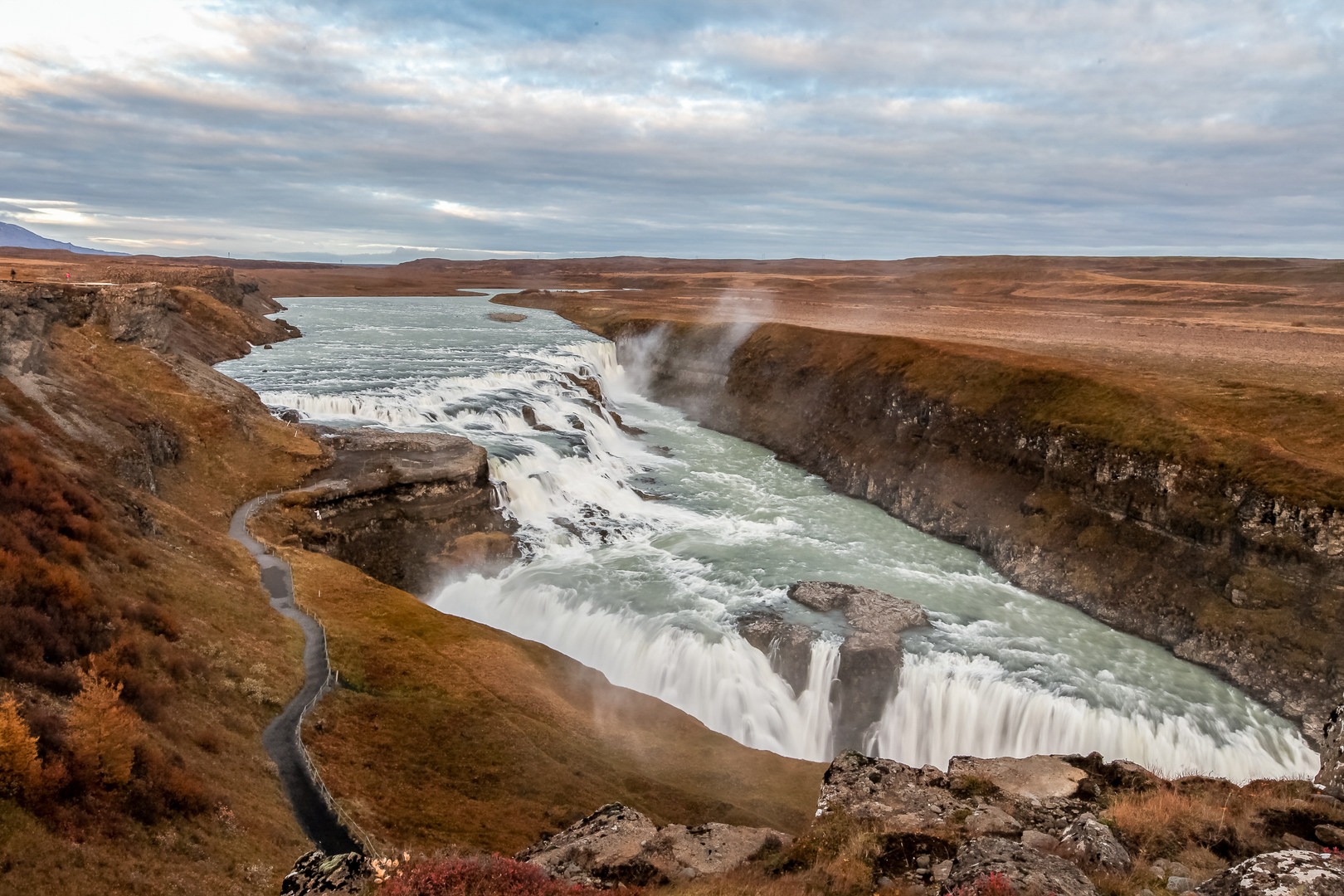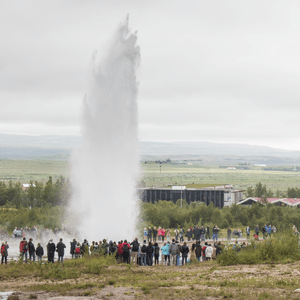You are here
Gullfoss is a massive two-tier waterfall in the southwestern region of Iceland that thunders down the Hvitá River and drops 32 meters (105 feet) into the Olfusa Canyon. It’s one of the most famous waterfalls in the country, and it is visited by thousands of people every day. Located about 75 kilometers (47 miles) northeast of Reykjavík, this is a primary point of interest in the Golden Circle. The waterfall is on public land and can be visited free of charge. There are several observation platforms and walking paths that allow you to explore multiple canyon layers and viewing perspectives. Take care on this slippery path, and prepare to face a lot of heavy mist.
This waterfall has a number of unique attributes that contribute to its grand power and size. Upon your approach, the bottom of Gullfoss will be obscured by the canyon, so the water appears to plummet into the depths of the earth. While the river flows south, the falls make a sudden right into a cascade of layers. The river then drops in two steps; an 11-meter (36-foot) stage followed by a 21-meter (69-foot) stage. Near the parking area on the top level there are two platforms, and if the wind is blowing to the north, you’ll get misted on the one that’s upstream. From here you can see a contrasting color of backgrounds as the landscape transitions from striking moss green along the banks to volcanic dark gray in the surrounding hills to snowy peaks further to the interior. A staircase leads down to a lower level and parking area with another platform and a dirt path to a rock formation overlooking the falls. On sunny afternoons you’ll have the pleasure of seeing a rainbow! There are limited safety implements, so watch your step and be extra careful on the wet surfaces. Cover your camera, because you will get wet!
The Hvítá River gets its name, “White River,” from the light-colored glacial sediment it carries. It begins at the glacier called Langjökull in Hvitarvatn and flows to the Sogid River near the town Selfoss before emptying into the ocean. This gorge was formed by flash flood waters that forced their way through cracks in basalt lava layers and ripped away the land. This gorge extends about 20 meters (66 feet) in width and 2.5 kilometers (1.6 miles) downstream. The amount of water averages about 140 cubic meters per second (4,900 cubic feet per second) in the summer and 80 cubic meters per second (2,800 cubic feet per second) in the winter. There are distinct banded ash layers in the canyon walls that signify various volcanic eruptions that have occurred over time. In some instances, flood waters have been so great that the gorge below the falls has overflowed. The highest recorded flow rate ever measured was 2,000 cubic meters per second(71,000 cubic feet per second)!
Gullfoss, or “Golden Waterfall,” may get its name from an old tale found in the travel journal of Sveinn Pálsson. There once was a farmer named Gýgur who lived at Gýgjarhóll and who possessed a lot of gold. As he approached the end of his life, he could not bear the thought of someone else ever having it, so he placed it all in a coffer and threw it into the waterfall.
More recently, this waterfall played a significant role in the foundation of Iceland’s environmental preservation values. In the early 20th century, foreign investors wanted to create a hydroelectric plant that would harness the massive power of the falls. Tómas Tómasson, a farmer who owned Gullfoss at the time, accepted a bid to lease the land to an Englishman who was to lead the project. Sigriður Tómasdóttir, who was Tómas’ daughter and who grew up on the farm, fought to void the contract for the purpose of preserving the falls in its natural state. The case was brought to trial in Reykjavík, and after three years of arbitration, the court sided with the tenant. By that time though, the contract had been terminated due to the Englishman’s failure to pay his rental fees. In 1940, Sigriður’s adopted son acquired the waterfall from Sigriður´s father and later sold it to the Icelandic government. This would ensure its permanent protection, and in 1979, the area was designated as a nature reserve. Today, Sigriður is memorialized by a monument at the falls and recognized as one of Iceland’s first environmentalist.
There is a restaurant/café next to Gullfoss that offers diverse options of hot food and sandwiches, hot and cold drinks, desserts and cakes, as well as their lamb soup. It is open weekdays and weekends from 10:00 to 19:00. Hótel Gulfoss is approximately 3 kilometers (2 miles) from the falls, and has resort-like atmosphere. Each room has a private bathroom and is “classically furnished with comfortable beds.”
The Golden Circle hosts many other points of interest for you to travel to and explore; Þingvellir National Park, Geysir and Strokkur in the Haukadalur geothermal area, the Kerið volcanic crater, the Nesjavellir and Hellisheiðarvirkjun geothermal power plants, and Laugarvatn Fontana geothermal baths.
Logistics + Planning
Current Weather: Powered by Dark Sky



























Comments
Sign In and share them.